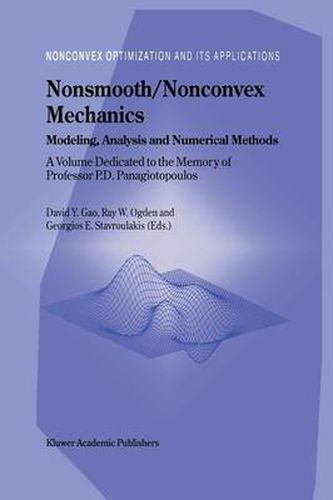Readings Newsletter
Become a Readings Member to make your shopping experience even easier.
Sign in or sign up for free!
You’re not far away from qualifying for FREE standard shipping within Australia
You’ve qualified for FREE standard shipping within Australia
The cart is loading…






This title is printed to order. This book may have been self-published. If so, we cannot guarantee the quality of the content. In the main most books will have gone through the editing process however some may not. We therefore suggest that you be aware of this before ordering this book. If in doubt check either the author or publisher’s details as we are unable to accept any returns unless they are faulty. Please contact us if you have any questions.
Nonsmoothness and nonconvexity arise in numerous applications of mechan- ics and modeling due to the need for studying more and more complicated phe- nomena and real life applications. Mathematicians have started to provide the necessary tools and theoretical results underpinning these applications. Ap- plied mathematicians and engineers have begun to realize the benefits of this new area and are adopting, increasingly, these new tools in their work. New computational tools facilitate numerical applications and enable the theory to be tested, and the resulting feedback poses new theoretical questions. Because of the upsurge in activity in the area of nonsmooth and noncon- vex mechanics, Professors Gao and Ogden, together with the late Professor P.D. Panagiotopoulos, had planned to organize a Minisymposium with the title Nonsmooth and Nonconvex Mechanics within the ASME 1999 Mechanics & Materials Conference, June 27-30 1999, Blacksburg, Virginia. After the unex- pected death of Professor Panagiotopoulos the first two editors invited the third editor (Professor Stavroulakis) to join them. A large number of mathematical and engineering colleagues supported our efforts by presenting lectures at the Minisymposium in which the available mathematical methods were described and many problems of nonsmooth and nonconvex mechanics were discussed. The interest of the many participants encourages us all to continue our research efforts.
$9.00 standard shipping within Australia
FREE standard shipping within Australia for orders over $100.00
Express & International shipping calculated at checkout
This title is printed to order. This book may have been self-published. If so, we cannot guarantee the quality of the content. In the main most books will have gone through the editing process however some may not. We therefore suggest that you be aware of this before ordering this book. If in doubt check either the author or publisher’s details as we are unable to accept any returns unless they are faulty. Please contact us if you have any questions.
Nonsmoothness and nonconvexity arise in numerous applications of mechan- ics and modeling due to the need for studying more and more complicated phe- nomena and real life applications. Mathematicians have started to provide the necessary tools and theoretical results underpinning these applications. Ap- plied mathematicians and engineers have begun to realize the benefits of this new area and are adopting, increasingly, these new tools in their work. New computational tools facilitate numerical applications and enable the theory to be tested, and the resulting feedback poses new theoretical questions. Because of the upsurge in activity in the area of nonsmooth and noncon- vex mechanics, Professors Gao and Ogden, together with the late Professor P.D. Panagiotopoulos, had planned to organize a Minisymposium with the title Nonsmooth and Nonconvex Mechanics within the ASME 1999 Mechanics & Materials Conference, June 27-30 1999, Blacksburg, Virginia. After the unex- pected death of Professor Panagiotopoulos the first two editors invited the third editor (Professor Stavroulakis) to join them. A large number of mathematical and engineering colleagues supported our efforts by presenting lectures at the Minisymposium in which the available mathematical methods were described and many problems of nonsmooth and nonconvex mechanics were discussed. The interest of the many participants encourages us all to continue our research efforts.